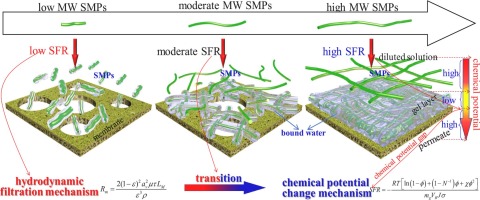当前位置:
X-MOL 学术
›
Chemosphere
›
论文详情
Our official English website, www.x-mol.net, welcomes your
feedback! (Note: you will need to create a separate account there.)
Effects of molecular weight distribution of soluble microbial products (SMPs) on membrane fouling in a membrane bioreactor (MBR): Novel mechanistic insights.
Chemosphere ( IF 8.1 ) Pub Date : 2020-01-25 , DOI: 10.1016/j.chemosphere.2020.126013 Jiaheng Teng 1 , Liguo Shen 1 , Yanchao Xu 1 , Yifeng Chen 1 , Xi-Lin Wu 1 , Yiming He 2 , Jianrong Chen 1 , Hongjun Lin 1
Chemosphere ( IF 8.1 ) Pub Date : 2020-01-25 , DOI: 10.1016/j.chemosphere.2020.126013 Jiaheng Teng 1 , Liguo Shen 1 , Yanchao Xu 1 , Yifeng Chen 1 , Xi-Lin Wu 1 , Yiming He 2 , Jianrong Chen 1 , Hongjun Lin 1
Affiliation

|
While molecular weight distribution (MWD) is one of the most important properties of soluble microbial products (SMPs), mechanisms underlying effects of MWD of SMPs on membrane fouling have not well unveiled. In this study, it was found that, the supernatant of sludge suspension in a membrane bioreactor (MBR) for wastewater treatment can be fractionated into a series of SMPs samples with different molecular weight (MW) fraction. The real gel sample mainly formed by the rejected SMPs on membrane surface had a high specific filtration resistance (SFR) of 1.21 × 1016 m-1 kg-1. The SFR of SMPs samples and the model foulants of polyethylene glycol (PEG) increased with their MW. The change trend of SFR with MW cannot be sufficiently explained by three-dimensional excitation-emission matrix (EMM) and chemical compositions. Tyndall effect analysis indicated that gelating ability of SMPs and PEG in the solution increased with their MW. Scanning electron microscope (SEM) confirmed gel structure changes with the PEG MW. Accordingly, mechanisms based on Carman-Kozeny equation and Flory-Huggins lattice theory were proposed to interpret SFR of SMPs with low and high MW, respectively. Simulating these two mechanistic models on PEG samples resulted in the comparable SFR data to the experimental ones, indicating the correctness and feasibility of the proposed mechanisms. The proposed mechanisms provided in-depth understanding of membrane fouling regarding MW, facilitating to develop effective membrane fouling mitigation strategies.
中文翻译:

可溶性微生物产物(SMPs)的分子量分布对膜生物反应器(MBR)中膜污染的影响:新颖的机理见解。
尽管分子量分布(MWD)是可溶性微生物产品(SMP)的最重要特性之一,但尚未很好地揭示SMP的MWD对膜污染的影响机理。在这项研究中,发现可以将膜生物反应器(MBR)中用于废水处理的污泥悬浮液的上清液分离为一系列具有不同分子量(MW)分数的SMPs样品。主要由膜表面上被拒绝的SMP形成的真实凝胶样品具有1.21×1016 m-1 kg-1的高比过滤阻力(SFR)。SMP样品的SFR和聚乙二醇(PEG)的模型污垢随其MW的增加而增加。SFR随MW的变化趋势不能用三维激发-发射矩阵(EMM)和化学成分充分解释。廷德尔效应分析表明,溶液中SMP和PEG的胶凝能力随分子量的增加而增加。扫描电子显微镜(SEM)证实了PEG MW引起的凝胶结构变化。因此,提出了基于Carman-Kozeny方程和Flory-Huggins晶格理论的机理来分别解释低MW和高MW的SMP的SFR。在PEG样品上模拟这两种机理模型可以得到与实验相当的SFR数据,表明所提出机制的正确性和可行性。所提出的机制提供了对膜污染的深入了解,有助于开发有效的膜污染缓解策略。扫描电子显微镜(SEM)证实了PEG MW引起的凝胶结构变化。因此,提出了基于Carman-Kozeny方程和Flory-Huggins晶格理论的机理来分别解释低MW和高MW的SMP的SFR。在PEG样品上模拟这两种机理模型可以得到与实验相当的SFR数据,表明所提出机制的正确性和可行性。所提出的机制提供了对膜污染的深入了解,有助于开发有效的膜污染缓解策略。扫描电子显微镜(SEM)证实了PEG MW引起的凝胶结构变化。因此,提出了基于Carman-Kozeny方程和Flory-Huggins晶格理论的机理来分别解释低MW和高MW的SMP的SFR。在PEG样品上模拟这两种机理模型可以得到与实验相当的SFR数据,表明所提出机制的正确性和可行性。所提出的机制提供了对膜污染的深入了解,有助于开发有效的膜污染缓解策略。在PEG样品上模拟这两种机理模型可以得到与实验相当的SFR数据,表明所提出机制的正确性和可行性。所提出的机制提供了对膜污染的深入了解,有助于开发有效的膜污染缓解策略。在PEG样品上模拟这两种机理模型可以得到与实验相当的SFR数据,表明所提出机制的正确性和可行性。所提出的机制提供了对膜污染的深入了解,有助于开发有效的膜污染缓解策略。
更新日期:2020-01-26
中文翻译:

可溶性微生物产物(SMPs)的分子量分布对膜生物反应器(MBR)中膜污染的影响:新颖的机理见解。
尽管分子量分布(MWD)是可溶性微生物产品(SMP)的最重要特性之一,但尚未很好地揭示SMP的MWD对膜污染的影响机理。在这项研究中,发现可以将膜生物反应器(MBR)中用于废水处理的污泥悬浮液的上清液分离为一系列具有不同分子量(MW)分数的SMPs样品。主要由膜表面上被拒绝的SMP形成的真实凝胶样品具有1.21×1016 m-1 kg-1的高比过滤阻力(SFR)。SMP样品的SFR和聚乙二醇(PEG)的模型污垢随其MW的增加而增加。SFR随MW的变化趋势不能用三维激发-发射矩阵(EMM)和化学成分充分解释。廷德尔效应分析表明,溶液中SMP和PEG的胶凝能力随分子量的增加而增加。扫描电子显微镜(SEM)证实了PEG MW引起的凝胶结构变化。因此,提出了基于Carman-Kozeny方程和Flory-Huggins晶格理论的机理来分别解释低MW和高MW的SMP的SFR。在PEG样品上模拟这两种机理模型可以得到与实验相当的SFR数据,表明所提出机制的正确性和可行性。所提出的机制提供了对膜污染的深入了解,有助于开发有效的膜污染缓解策略。扫描电子显微镜(SEM)证实了PEG MW引起的凝胶结构变化。因此,提出了基于Carman-Kozeny方程和Flory-Huggins晶格理论的机理来分别解释低MW和高MW的SMP的SFR。在PEG样品上模拟这两种机理模型可以得到与实验相当的SFR数据,表明所提出机制的正确性和可行性。所提出的机制提供了对膜污染的深入了解,有助于开发有效的膜污染缓解策略。扫描电子显微镜(SEM)证实了PEG MW引起的凝胶结构变化。因此,提出了基于Carman-Kozeny方程和Flory-Huggins晶格理论的机理来分别解释低MW和高MW的SMP的SFR。在PEG样品上模拟这两种机理模型可以得到与实验相当的SFR数据,表明所提出机制的正确性和可行性。所提出的机制提供了对膜污染的深入了解,有助于开发有效的膜污染缓解策略。在PEG样品上模拟这两种机理模型可以得到与实验相当的SFR数据,表明所提出机制的正确性和可行性。所提出的机制提供了对膜污染的深入了解,有助于开发有效的膜污染缓解策略。在PEG样品上模拟这两种机理模型可以得到与实验相当的SFR数据,表明所提出机制的正确性和可行性。所提出的机制提供了对膜污染的深入了解,有助于开发有效的膜污染缓解策略。











































 京公网安备 11010802027423号
京公网安备 11010802027423号